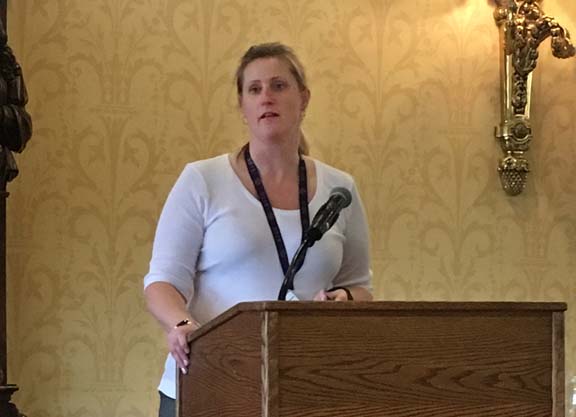By Bill Finley
STANTON, DE–The Jockey Club and many politicians are pushing for the U.S. Anti-Doping Agency (USADA) to become the sport's police force when it comes to drugs and medications, but at least one racing regulator believes that involving that organization would lead to nothing but problems.
Those remarks were made by Delaware Thoroughbred Racing Commission Chairman W. Duncan Patterson at yesterday's meeting of the Organization of Racing Investigators held on the grounds of Delaware Park.
Patterson was one of many speakers brought in to give views on how the industry can best deal with integrity and safety issues and protect itself and the wagering public from would-be cheats. Many opinions were offered, but none quite as strong as Patterson's, who spoke passionately as he argued against involvement from the federal government and USADA.
“Currently, you have the Thoroughbred Horseracing Integrity Act of 2015 and basically this enables USADA to be in charge of all medication, drug testing and penalties in racing. I'm absolutely amazed at the number of entities that are supporting this bill,” he said. “I am sure the supporters are looking at the issue on the surface because if you dig down deep there are so many fallacies to this. USADA, which comes under the World Anti-Doping Agency, strictly does human testing. Even in the Olympics, WADA does not do the equine testing.
“The medications that are approved by USADA are some medications which we do not allow in racing at any threshold level. By the same token, there are other medications we allow that they don't allow. So our whole medication schedule would have to be revamped under this. Currently USADA does 8,400 tests a year. Nationwide, we do 300,000 tests. Travis Tygart, the head of USADA, is obviously very knowledgeable, but when asked what plan he had to ramp up his testing by almost 40 times, he had no plan. When asked about the costs of their tests we were told about $1,000 a test. Currently, we spend, nationally, $30 million on testing. Simple math will tell you we will go from $30 million to $300 million. Who in the hell is going to pay for that?”
Patterson also argued that hay, oats and water advocates, those who believe racing would be better off without so many legal medications, including Lasix, are being unrealistic.
“It has been proven that Lasix is really necessary,” he said. “Some may disagree, but it's really necessary to keep the horses running. And there are other medications used on regular basis that are needed. Unfortunately there is abuse, but saying that the horse can perform on hay, oats and water is totally unrealistic. Human athletes do not perform on water, greens and meat. They need something.”
Dr. Dionne Benson, the executive director and CEO of the Racing Medication and Testing Consortium, assumed the role of teacher in her presentation, a tutorial on how best to inspect a veterinarian's truck to find banned substances. She brought in an actual truck and included among the many medications a handful that were illegal. Three investigators were chosen to search the truck in an attempt to find anything that should not be included among the supplies of a reputable vet. Benson gave the investigators good marks after their search uncovered the illicit substances.
Benson's presentation led to a discussion as to what penalties should be levied against vets who are caught with banned substances and whether or not they, along with the trainer, should be suspended when a horse tests positive. Benson said suspending vets for a drug positive would be impractical, but said the typical fine they are handed when caught with banned drugs is usually far too small.
“You might see a vet get a $5,000 fine when they are caught,” she said. “If I were meting out the punishments it wouldn't be $5,000, but $5,000 for every bottle of something illegal they were caught with. If you did that, you would never again have a problem. No vet would take that risk. It just wouldn't be worth it.”
Curtis Linnell and Laura Horah, wagering experts employed by the TRPB, gave a presentation on the last-second fluctuation in odds, a source of frustration for many horseplayers who feel cheated on the occasions when their horse goes into the gate at one price only to have the price drop dramatically during the middle of the race.
Horah said some tracks have gone to updating the odds every 30 seconds inside three minutes to post instead of every 60 seconds. She said that simple change dramatically cut down on the odds fluctuations from the penultimate set of odds shown to the public to the final odds.
The problem of dramatic late odds changes has become a bigger issue than ever due to the large amounts bet at the very last moment by computer players.
“We're moving to shorter update times all the time,” Horah said. “Ideally, we'd like to see the odds displayed to the public in as close to real time as possible.”
Not a subscriber? Click here to sign up for the daily PDF or alerts.






